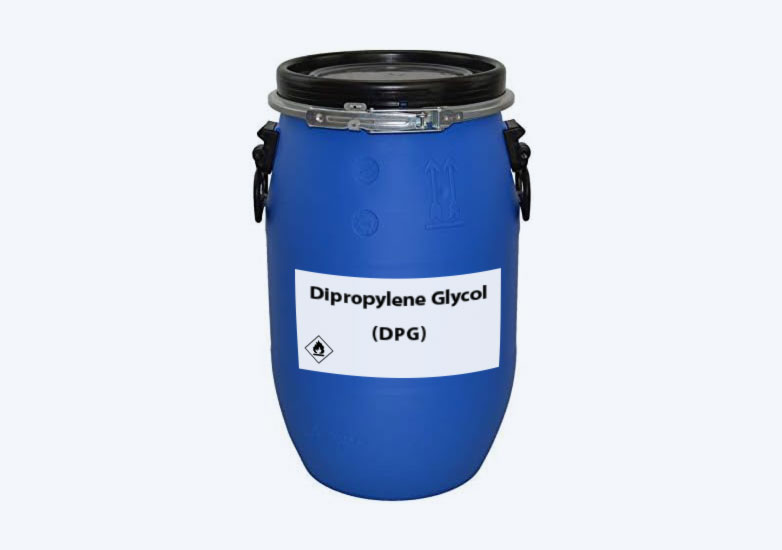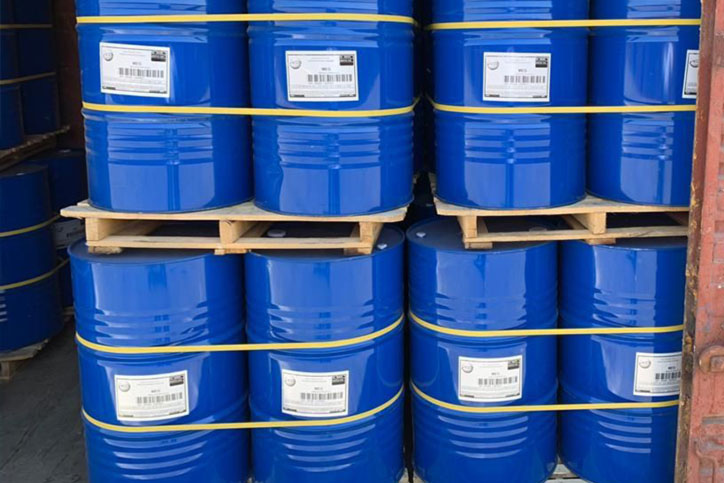Dipropylene Glycol – CAS#: 25265-71-8
Bulk Order
Diethylene glycol serves a variety of purposes in different industries. It is utilized in the production of unsaturated polyester resins, plasticizers, and polyurethanes. It also acts as a solvent for organic compounds such as nitrocellulose, oils, resins, and dyes. In addition, it is a key component in brake fluid, lubricants, and heating/cooking fuel. Furthermore, it can be found in personal care products such as skin creams, lotions, and deodorants.
A clear, colorless, and odorless liquid organic compound that belongs to the family of glycols, which are compounds that contain two hydroxyl (-OH) groups attached to adjacent carbon atoms. DPG is a viscous liquid that is miscible with water and many organic solvents.
ISO 9001, ISO 14001, ISO 13485, and ISO 45001
| Class | Glycols |
|---|---|
| MOLECULAR WEIGHT | 134.17 |
| APPEARANCE | Colorless viscous liquid |
| DENSITY | 1.023 g/cm3 |
| REFRACTIVE INDEX | 1.441 |
| ASSAY | 99 % |
| BOILING POINT | 231 – 235 °C |
| MELTING POINT | -32 °C |
- Drums
- Intermediate bulk containers (IBCs)
- Flexitanks
- Tank trucks
What is the Dipropylene Glycol?
Dipropylene glycol (DPG) is a versatile and widely used chemical that serves a variety of purposes in different industries. It is commonly utilized as a plasticizer in the production of plastics and polymers, where it helps to improve flexibility, durability, and other mechanical properties of the final products.
In addition, DPG can act as an intermediate in a range of industrial chemical reactions, particularly in the production of resins, synthetic fibers, and other chemical compounds. It can also serve as a polymerization initiator or monomer, allowing for the creation of more complex molecules and structures.
DPG is also a useful solvent for many organic compounds such as oils, resins, and dyes. Its low toxicity and solvent properties make it a valuable additive in perfumes, skin care, and hair care products. It can help to evenly distribute fragrances and other active ingredients in these products, while also acting as a moisturizer and humectant.
What is Dipropylene Glycol Used For?
Diethylene glycol (DEG) is a versatile chemical with a wide range of industrial and consumer applications. Here are some of the most common uses of DEG:
Dipropylene Glycol is used in the production of a variety of products, including polyester resins, polyurethanes, and plasticizers.
Dipropylene Glycol is an effective solvent for a variety of organic compounds, such as oils, dyes, and resins.
Used in the production of personal care products, such as skin creams, lotions, and deodorants.
Used as a solvent and a stabilizer in the production of pharmaceuticals.
Dipropylene Glycol is used in the production of textile fibers, such as polyester and nylon.
It’s used as a solvent in the production of adhesives, such as those used in the construction industry.
Dipropylene Glycol Industry Used
This substance is used in the production of the following materials:
- Chemical manufacturing
- Solvent
- Antifreeze
- Personal care products
- Pharmaceuticals
- Textile industry
- Adhesives
Dipropylene Glycol Safety Procedures
Dipropylene glycol (DPG) is a chemical that can be hazardous if not handled or used properly. Here are some important safety warnings to keep in mind:
- DPG can be harmful if ingested, inhaled, or absorbed through the skin. Always wear appropriate personal protective equipment (PPE) when working with DPG, including chemical-resistant gloves, safety glasses, and a lab coat or protective clothing.
- DPG should be handled with care to avoid spills or splashes. Use proper lifting techniques and avoid dropping or jostling containers of DPG.
- DPG should be stored in a secure, designated area away from other chemicals or materials that could react with it. It should be stored in a cool, dry, well-ventilated area and kept away from sources of heat or ignition.
- DPG should only be used in well-ventilated areas to prevent the buildup of toxic fumes or vapors.
- In case of skin contact, immediately wash the affected area with soap and water. In case of eye contact, rinse with plenty of water for several minutes and seek medical attention if irritation persists.
- In case of ingestion or inhalation, seek medical attention immediately and provide the medical personnel with the Safety Data Sheet (SDS) for DPG.


